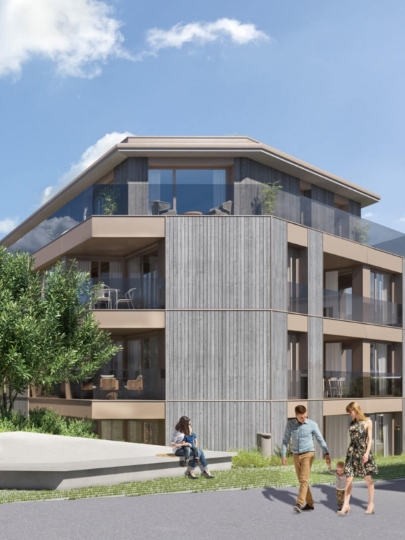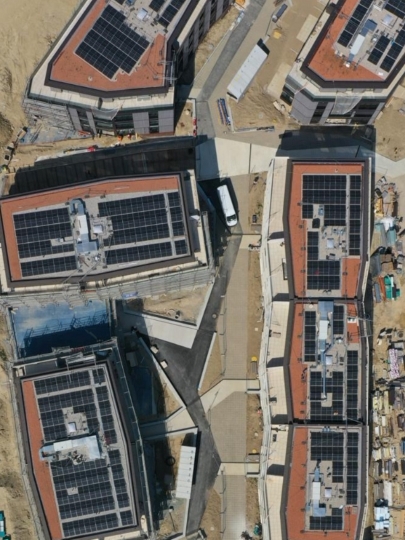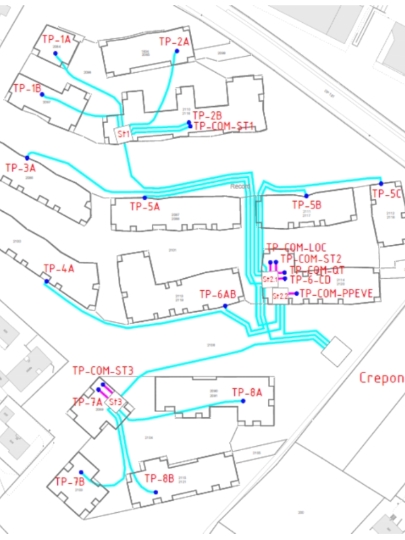Microgrid Echallens – Osiris
Microgrids play a key role in the energy transition and the Swiss sustainability agenda. Switzerland aims to be climate-neutral by 2050 and microgrids are a key instrument in achieving this goal.
We were able to contribute our technology to the microgrid project in Echallens – Osiris. It was implemented by our partner Romande Energie. Romande Energie is the largest electricity supplier in Romandy and is involved in four key areas of the energy transition: Renewable energy production, energy distribution, energy billing and installation services. The energy supply company covers all four areas in the Osiris project.

Source: Osiris Echallens
A merger for self-consumption
In Echallens, the connection for self-consumption was set up with its own microgrid. Microgrids offer the possibility of efficiently utilising and distributing locally generated renewable energy, which reduces dependence on central electricity grids. Another contributing factor is security of supply.
The principle of self-consumption is that locally produced electricity is used directly by local residents. Electricity from the public grid is only utilised when local demand cannot be met. Any unused local electricity is fed into the public grid.
Win- Win- Win
The advantages of the microgrid are shared by all parties involved:
Owners:
- Reduced investment and maintenance costs
- Increased ratio of renewable energy
- Promotes sustainability and innovation
Consumers:
- Lower energy costs
- More local and renewable energy
Romande Energie:
- Increase in renewable energy production
- Acquiring new customers outside the supply area

Source: Steiner SA
Technical details of the project
Apartments according to Minergie ECO standard
Electricity meters from smart-me
Annual production
%
Self-consumption
Microgrid infrastructure
The Osiris microgrid is an outstanding example of the integration of renewable energy sources and the promotion of sustainable energy concepts. The following grid infrastructure was created for its realization:
Medium-voltage grid connection: The microgrid is connected to the medium-voltage distribution grid of the utility grid operator (VNB), which ensures a reliable power supply.
Transformer station: A transformer station is integrated into the microgrid. This allows the consumer to benefit from medium-voltage tariffs.
Transformers 1000 kVA: The microgrid has three transformers with a capacity of 1000 kVA, which allow the various users in the microgrid to be reliably supplied.
Main distribution lines: The microgrid is structured by four main distribution lines that efficiently distribute the current flow and connect the different parts of the microgrid.
Sub-distribution lines: There are a total of 21 sub-distribution lines that transmit the electricity to the various buildings and consumers within the microgrid.
Source: Romande Energie SA
Challenges and solutions
There were a number of challenges during this project, including changing contacts at the general contractor and a significant coordination effort. In these situations, it was the ability to solve problems that counted, as Eric Albers, the project manager, emphasized: “As a project manager, I’m not paid to ensure that there are no problems. I am paid to solve problems.” Our smart-me technology, especially the WiFi connection, proved to be extremely helpful during troubleshooting and commissioning
Efficient data measurement and billing
A total of around 500 smart-me meters were installed in 32 panels. A main meter was installed in each building to monitor energy consumption. Data is recorded for apartments, common areas, heat pumps, electromobility and photovoltaic output. The project also includes the recording and billing of heat, water and cold water. 60 M-Bus gateways were integrated, which bring the data from 1400 third-party meters into the cloud.
Eric Albers particularly appreciates the smart-me meters:
- WiFi connection: Eric Albers emphasizes the WiFi connection of the smart-me meters. This technology enables a wireless connection to the meters and offers the advantage that data can be transmitted in real time. This considerably simplifies troubleshooting and commissioning.
- Simple troubleshooting: The WiFi connection makes troubleshooting much easier. Eric Albers emphasizes that troubleshooting smart-me meters is much easier compared to Modbus connections or other connection methods. This helps to identify and solve problems quickly.
- Real-time data in the web portal: The ability to view phases and live data in real time in the web portal is seen as a major advantage both during commissioning and during operation. This enables better monitoring and optimization of energy consumption.
Romande Energie uses the smart-me API to transfer data to its own billing tool. This meant that the customer service team did not have to be retrained and the internal processes remained essentially the same.
Microgrids will gain in importance
Overall, the future of microgrids in Switzerland will be driven by the need for a sustainable, decentralized energy supply and technological advances in this area. The number of microgrid projects is expected to increase as Switzerland steps up its efforts to achieve its energy and climate policy goals.
The Echallens – Osiris microgrid is an outstanding showcase for sustainable energy supply and demonstrates the effectiveness of our smart-me technology in monitoring and optimizing microgrids. We look forward to future partnerships that will drive the energy transition forward.
Write us
You are welcome to send us your request using the form below.
This site is protected by reCAPTCHA and the Google Privacy Policy and Terms of Service apply.
